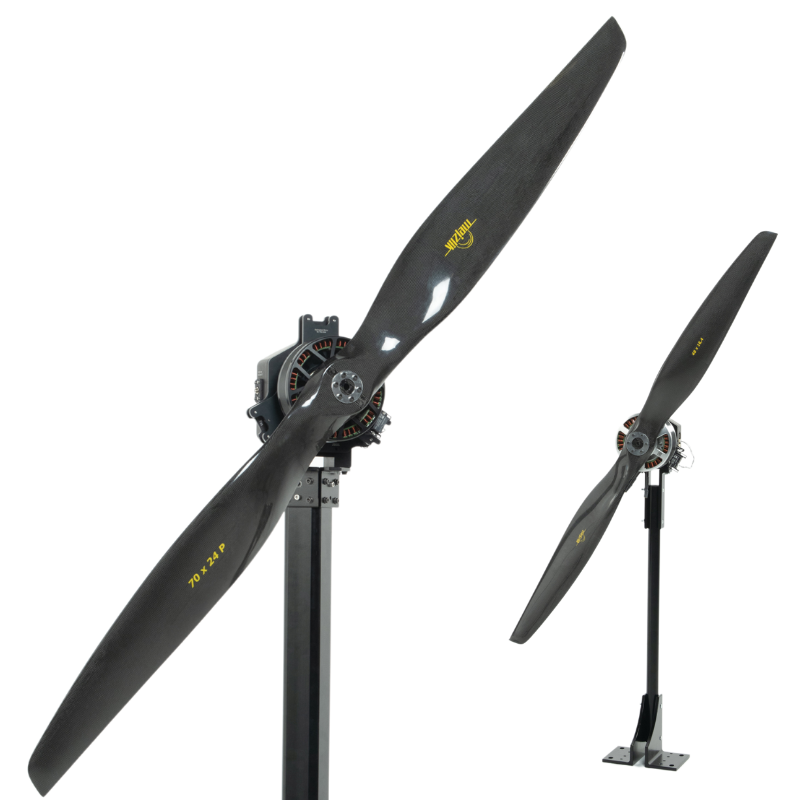In our 2022-2023 design cycle for the SAE Aero Design competition, we (University of Alberta Aero Design) decided to step outside our comfort zone and participate in the Micro Class design challenge for the very first time in our clubs 37-year history (historically our club has participated exclusively in Regular or Advanced classes).
In the Micro Class, there were new challenges that demanded an optimized propulsion system such as a 450 W power limit, a 4s LiPo battery, an 8 ft maximum take-off distance, and a 36” maximum wingspan. With these requirements, we realized it was more important than ever to characterize the performance of our propulsion system in detail as every additional amount of thrust we can produce with our limited power can make a significant difference.
In November of 2022, Tyto Robotics helped us achieve our goal by sponsoring our purchase of the Series 1580 Test Stand. The Series 1580 Test Stand was robust and easy to set up, allowing us to perform multiple static tests under different conditions with minimal downtime. The test stand came in a box with all the components required for its operation including the hardware, load cells, motor mounting plate, calibration tools, and electrical components.

Figure 1: Series 1580 Test Stand installed in a wind tunnel
Before receiving the test stand, a rigorous analysis of various propeller, motor, electronic speed controller (ESC), and battery combinations was performed in MATLAB to converge on a set of combinations that will maximize thrust within the available 450 W while operating near the motor’s peak efficiency.
The three main goals of the tests were to:
- Characterize each propeller's thrust efficiency (thrust/electric power).
- Determine how the battery voltage, thrust, electrical power, and RPM changed over 90 seconds when drawing 450 W (a typical flight attempt is 60 seconds).
- Measure the motor efficiency at our expected operating points.
To achieve the first goal, each propeller was tested at five 500 RPM increments up to its maximum RPM. The maximum RPM was set by an electrical power draw of 450 W. Using the continuous recording feature offered by the versatile and user-friendly RCbenchmark software, 500 samples were recorded at each testing condition, and the average values were calculated.
To accomplish the second goal, each propeller was held at 450 W for 90 seconds.
For the third goal, the test data showed that the motor was operating at around 76-80% efficiency for all the tested RPMs.
After performing these tests, we were able to refine and validate our selected propulsion system by:
- Determining the thrust each propeller generates when drawing 450W of power or less, and the maximum power each propeller draws at full throttle.
- Determining which propeller produced more thrust with the same electrical power input.
- Quantifying the decrease in battery voltage, power and thrust we can expect with time.
- Identifying the discrepancy between the propeller manufacturer’s reported values and the experimental results.
The Series 1580 Test Stand offered various other useful features such as the ability to measure the RPM of the propeller both electronically and by using an optical RPM probe.
In addition to the parameters mentioned above, the test stand was able to measure motor torque as well as vibrations in 3 axes which provided valuable insight into the aircraft’s structural, stability and control considerations. Due to the
difficulty in measuring these parameters, these factors may have been overlooked otherwise.
From our testing, we were able to validate our motor, propeller, and battery choice. Furthermore, we can now more accurately and reliably calculate our flight performance. Future tests will be conducted in the Laboratory of Turbulent Flow's wind tunnel to characterize the dynamic thrust so the take-off and cruise performance can be modelled more accurately.

Figure 2: Side view of Series 1580 in wind tunnel
Aero Design would like to thank Tyto Robotics for their sponsorship, as it enabled us to purchase the Series 1580 thrust stand which is highly robust, accurate, and user friendly. It is perfect for conducting thrust tests in different conditions to validate a propulsion system and measure various parameters such as propeller thrust, propeller RPM, current, voltage, motor torque, and efficiency.
Deep Rajani – VP Finance & Aerodynamics Team Lead (Author)
Daniel Kichma – Propulsion Team Lead (Author)
Ejouan Agena – Senior Design Team Member
Mckenna Warawa – Design Team Member
Michael Caulfield – Design Team Member
SAE Aero Design Team




 Back to Blog
Back to Blog


Leave a comment